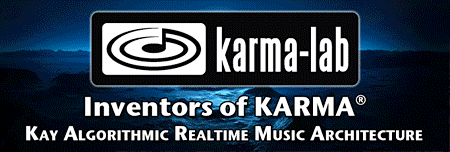aron wrote:BTW: can someone besides me try Stephen's karma trick. I cannot get it to work. I think I don't understand what it is trying to do.
I just tried it. Worked for me.
Did you start with an Init Combi?
1. Init Combi.
2. Set 4 different program sounds in the first 4 timbres, i.e. piano, strings, organ, brass.
3. On the KARMA GE Setup page, turn off Run on Module A (on by default).
4. On the Perf RTP Page (which has nothing assigned), set rows 1 to 4 to Key Zone, Thru In Zone. Default settings.
5. Check Modules A, B, C, D respectively on the four rows, in sequence.
6. Set Assign to the 4 rows, in sequence, to SW1, SW2, SW3, SW4.
7. Switch the Control surface to RT/KARMA.
8. The first four KARMA switches (yes, you circled three of them) should now activate the 4 timbres individually. Since these are stored in a scene, you can turn on SW1 in Scene 1, SW2 in scene 2, SW3 in scene 3, SW 4 in scene 4 (while turning the others off), or any mix of them in a particular scene. The reason to use the Scene switches is that one button push turns off one timbre switch and turns on another, or turns on several while turning off several. You could just do it manually as well within a single scene.
BTW, "Thru In Zone" refers to sending notes thru, if they happen to be in the range of the KARMA input zone key range on the KARMA GE Setup page. So you could actually set up different zones here, for different timbres. By default, the zone is 0~127 (the whole range) C-1 to G8 or whatever it is.
The concept of how this works is: A KARMA Module can take input notes from the input key zone, and "do stuff" with them. It can also, in addition, simply send them thru to the timbres. With the "Run" checkbox off, KARMA is not going to do any arpeggio or riff generation, but the Thru In Zone/Out Zone feature still works. You can send them thru "In Zone", whereby they are layered on top of what the KARMA GE is generating (or not, if Run is off), or you can send them "Thru Out Zone", in which case, you can make a split, and the bottom or top half goes into KARMA, while the rest of them (outside of the zone) are sent directly thru to the timbre.
In this case, with an INIT Combi, the key zone is set to the full range, so turning on the switch sends the notes thru to the timbre, for the entire keyboard; turning off the switch sends NO notes thru to the timbre. Hope that makes sense. This blocks the MIDI notes from going to the timbre; hence, it uses no polyphony.
If you don't start with an INIT combi, there are all sorts of other settings that may interfere or interact with what you are trying to do, because they are already programmed.
I can explain more about that if necessary, but the first step is to see if you can reproduce the example with an INIT combi.
Caveat: I didn't write the PDF in the referenced post, in fact, if you read the thread, the whole thing was a surprise to me...although they tried to say I told them about it myself (!), well maybe, but I really don't remember that. In any case, it's a really useful "trick".




